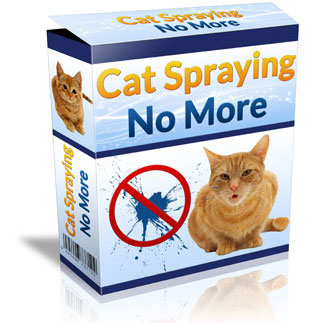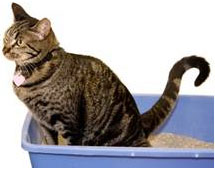Has your cat been peeing in places other than the litter box? It can be a frustrating and even an embarrassing situation. Your cat is not “bad” when they pee in other places outside the box. They are trying to communicate their needs.
There are many things you can do to sort out the problem and get your feline friend to stop. Here are 7 guidelines on how to stop a cat peeing everywhere.

1. Rule out any health issues
It is vital to rule out any health issues that may cause your cat to pee in other places. Your veterinarian will be able to diagnose and treat medical conditions that may be causing your cat to pee in other places. The veterinarian will do a physical exam and maybe other tests to determine if it is a medical or behavioral problem.
It could be your cat might be trying to let you know that it is experiencing pain or discomfort. Consequently, he/she might have a urinary tract infection, bladder stone, kidney disease, arthritis or diabetes.
2. Think about the litter box
Your initial step to solving your cat’s litter box avoidance is setting up the right box in the ideal location. Therefore, find a place for your cat’s litter box that is peaceful, out of the way and easily accessible. For example, the litter box should not be near their food or water bowl. Most cats fancy uncovered boxes, but if yours likes privacy, cover the box with a lid.
You may want to think about changing the type of cat litter you use. Make sure to clean the litter box daily by removing any clumps of urine or solid waste. The litter box should be washed out and new clean litter put in the box at least one a week. Also, for an aged cat you may need a shallow box or small ramp to climb into the box.
3. Deter cats from urine marking behaviour
Thoroughly clean up the mess. Make sure you have eliminated the odor. If you don’t, your cat will be drawn back to the same spot through the smell. Use household cleaning agents as well as an enzymatic or bacterial cleaner that targets the urine odor.
You need to recognize that cats have territorial needs. They need space of their own where they feel safe and secure. Make an area with scratching posts, toys, food bowl and other items. They must have a place that they can delve into away from areas where they could possibly pee.
4. Address your cat’s anxiety
If stress and anxiety are the cause, then it’s good to sort out the source of your cat’s nervousness. In other words, address your cat’s anxiety if it is suspected to be the source of misbehavior. Things that we might not think are stressful could cause much distress.
Loud noises, changes in the environment, feral cats in the neighborhood, are a few examples. Reducing noise and keeping the litter box in a quiet area will help. You can use feline calming treats or cat pheromone diffusers to reduce anxiety.
5. Reduce conflict between other pets
It may help to give your cat its own area or even a separate living space. If you don’t have the space, then think about getting a cat tree, constructing a perch or making a hiding place as a place of refuge for your cat. Equally important, having several litter boxes can also reduce conflict.
6. Think about getting your cat neutered
Intact male cats are well known for spraying to mark their territory. Therefore, you may decide to neuter your cat to prevent territory issues. Your veterinarian will guide you as to which age your cat can be neutered.
7. Reward your cat

You want to reinforce good habits. When your cat uses its litter box consistently reward him/her with treats or affection. What’s more, you want your cat to realize that the good action of peeing in the litter is the best option.
In Conclusion:
Cats by nature are clean animals, therefore if your cat is not peeing in its litter box there is a problem. The above are some possible causes of the problem and following the guidelines given will assist you in helping your feline friend, and equip you to know how to stop a cat peeing everywhere. Finally, strive to always be an attentive and responsible cat owner as you create a happy and loving home for you and your cat.
Watch the following video to get advice from a vet:
Cat Peeing Outside of the Litter Box? A Vet Explains Why
Video transcript summary:
This video was made to share all the knowledge about improper removal with you. It is not intended to replace the advice of your local veterinarian and does not constitute medical advice. When veterinarians or ethologists talk about inappropriate defecation, they mean any time your cat urinates or defecate in the house, not in the toilet. This accounts for about 50% of all behavioral visits to the veterinarian, and in about half of them, it is unfortunately the main reason cats are sent to shelters.
Debunking Myths
It’s really important to me to debunk the myths that permeate people’s collective consciousness about why cats behave the way they do. So let me tell you now, cats don’t urinate or defecate outside the toilet. They don’t get angry, they don’t take revenge, they don’t take revenge on you. In fact, they can’t conceptualize at that level. This is not how cats think. This is how humans think, and we project our ideas onto cats, but this is not true.
Besides, it doesn’t help either. It doesn’t solve the problem. right? If your cat does this, it sends the message that there is a problem and needs help. Therefore, urination or defecation outside the tray has four main causes.
Marking Territory
First, cats have health problems. Number 2 is marking her territory. Number 3 is stress. Four, cats don’t like being in crates. So let’s talk about why.
Mainly for medical reasons. You need to make sure your cat is not sick. The most common causes of feeling inappropriate elimination (I’ll call it F.I.E. from here on) include bladder inflammation and infection, kidney disease, diabetes, diarrhea, constipation, arthritis, or anything that makes urination or bowel movements painful.
Now sometimes cats with health problems prefer to use a sink or bathtub as a toilet. And we don’t even know why cats do that. Therefore, if your cat comes out of the litter box, the first thing you should do is take her to the veterinarian to make sure there are no health problems. And another helpful thing is bringing a urine sample, I know it can be difficult to collect urine from a cat, but it can help.
Territorial Stress
Then you have to distinguish F.I.E. Inappropriate feces and urine sensations that indicate what the cat is doing. These are two completely different questions. Therefore, male cats, particularly neutered male cats, mark their territory by urinating on both vertical and horizontal surfaces such as walls and furniture, which is mainly caused by territorial stress.
Other cats are approaching them and they need to tag everything to make sure they know this cat is staying away. So even the spraying male cat uses the toilet quite normally. And they usually have a few strategic spots around the house where they urinate.
A peeing cat is looking for something. When sniffing and twisting, the tail quivers and squirts out into the sniffing area, which urinating cats typically come to while squatting. etc. right? So if your cat is spraying, that’s a separate issue that I won’t be covering in this video, because that’s a completely different topic.
The Effect of Stress
We return to F.I.E. OK, again F.I. Therefore, the third reason for F.I.E. feeling of inadequate elimination is stress. See, there are many things that can stress your cat. People coming into your home can be a source of stress, and changing bedding can also be a source of stress. Moving furniture can be a source of stress. Mirrors can be a source of stress.
The fourth major factor causes an aversion to trays. Cats don’t like crate types. Cats don’t like hoodies. Cats don’t like plastic inserts. Cats don’t like the location of the box. Cats don’t like filler. Cats don’t like boxes to be dirty. Other cats use crates and continue to use crates. That’s why cats almost always defecate on a horizontal surface, so it’s often implied they don’t like litter boxes.
Therefore, they always strive for something else. They seem to target carpets, and pick the same spot over and over again. And they rarely use trays. Or they may use the toilet for urination instead of defecation, or vice versa. These cats will also have peculiar behavior. If you use a crate, it goes into the crate and then finishes very quickly after using it.
Behavior Patterns
The normal behavior of a cat in a mailbox is: Cats are happy to go into the box. The cat spends some time sniffing the box and exploring the corners before choosing the perfect spot, digs a hole, turns around, removes it, turns around to check out its masterpiece, and covers any excrement.
Other behaviors while your cat is on the potty will tell you that your cat doesn’t like what’s going on on the potty. Again, there are many reasons why cats hate crates. They don’t like dirty boxes. Some don’t like places with heavy traffic or noisy places. An oven and laundry room are also included. Unfortunately, it’s a pretty popular place for people to put kennels.
However, cat crates should be warm, quiet and comfortable. Right? Think comfort. It’s really noisy and scary if you sit by the stove when the lights come on. This is not very comfortable for your cat. Another common mistake you can make with potty options for cats is having too few crates.
Multiple Crates
Experts recommend having one more box than cats. So if you have two cats, three crates, etc. If you have multiple floors, place one on each floor of your home. Additionally, you should also use a litter that your cat likes. Cats do not like scented litter. We love the flavored fillings. They don’t like it. They like fine sand, lumpy, odorless litter.
Also, cleaning the box with harsh chemicals can cause severe irritation. They don’t like it. right? So you can either really ventilate this box for a few days or replace it with another box while you ventilate. Also, cats generally don’t like hood liners, electronic strobe lights, or music. We buy all the fancy litter boxes for our cats, but they don’t like them. Ah, one more.
The Bully Cat
You may have a bully cat who keeps other cats out of the box. So you have to play detective for a while and see what happens. If you have multiple cats, figure out who’s causing trouble, and if you have a bully cat causing litter problems, make sure the litter is well-placed in a clean, quiet, comfortable area, and have the required number of trays. Remove hood liners, plastic trays and use odorless litter, odorless sandy fine litter.
So do not hesitate in case you’ve attempted all of the stuff that I’ve advised you and you are nonetheless having a difficult time, do not hesitate to speak to your nearest veterinarian or a behaviorist.
Hopefully, after considering all the information on this page, you now know how to stop a cat peeing everywhere. Now, do you own a dog as well? Then you might find this article helpful:
How to stop your dog jumping up at guests
Podcast: Play in new window | Download
